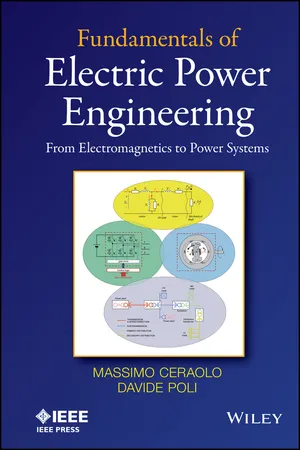
Fundamentals of Electric Power Engineering
From Electromagnetics to Power Systems
- English
- ePUB (mobile friendly)
- Available on iOS & Android
Fundamentals of Electric Power Engineering
From Electromagnetics to Power Systems
About This Book
This book serves as a tool for any engineer who wants to learn about circuits, electrical machines and drives, power electronics, and power systems basics
From time to time, engineers find they need to brush up on certain fundamentals within electrical engineering. This clear and concise book is the ideal learning tool for them to quickly learn the basics or develop an understanding of newer topics.
Fundamentals of Electric Power Engineering: From Electromagnetics to Power Systems helps nonelectrical engineers amass power system information quickly by imparting tools and trade tricks for remembering basic concepts and grasping new developments. Created to provide more in-depth knowledge of fundamentals—rather than a broad range of applications only—this comprehensive and up-to-date book:
- Covers topics such as circuits, electrical machines and drives, power electronics, and power system basics as well as new generation technologies
- Allows nonelectrical engineers to build their electrical knowledge quickly
- Includes exercises with worked solutions to assist readers in grasping concepts found in the book
- Contains "in-depth" side bars throughout which pique the reader's curiosity
Fundamentals of Electric Power Engineering is an ideal refresher course for those involved in this interdisciplinary branch.
For supplementary files for this book, please visit http://booksupport.wiley.com
Frequently asked questions
Information
Part I
Preliminary Material
- Introduction
- The Fundamental Laws of Electromagnetism

1
Introduction
1.1 The Scope of Electrical Engineering
- In some cases, electrical engineering is considered as encompassing those disciplines in which electrical quantities (voltages, currents) are used to transfer signals (e.g., in computers, radio and TV sets, etc.) and those in which electrical quantities are used to manage and transfer energy and power (electrical machines and lines, electrical household installations, etc.). This approach is, for instance, normally followed in North America.
- In other cases, electrical engineering is considered to be involved only when electrical quantities are used to transfer and convert energy and power. This approach is usually followed in Europe. This kind of electrical engineering is often called electric power engineering.
Table of contents
- Cover
- Series Page
- Title Page
- Copyright
- Dedication
- Preface
- About the Authors
- Part I: Preliminary Material
- Part II: Electric Circuit Concept and Analysis
- Part III: Electric Machines and Static Converters
- Part IV: Power Systems Basics
- Appendix: Transmission Line Modelling and Port-Based Circuits
- Selected References
- Answers to the Proposed Exercises
- Index
- End User License Agreement